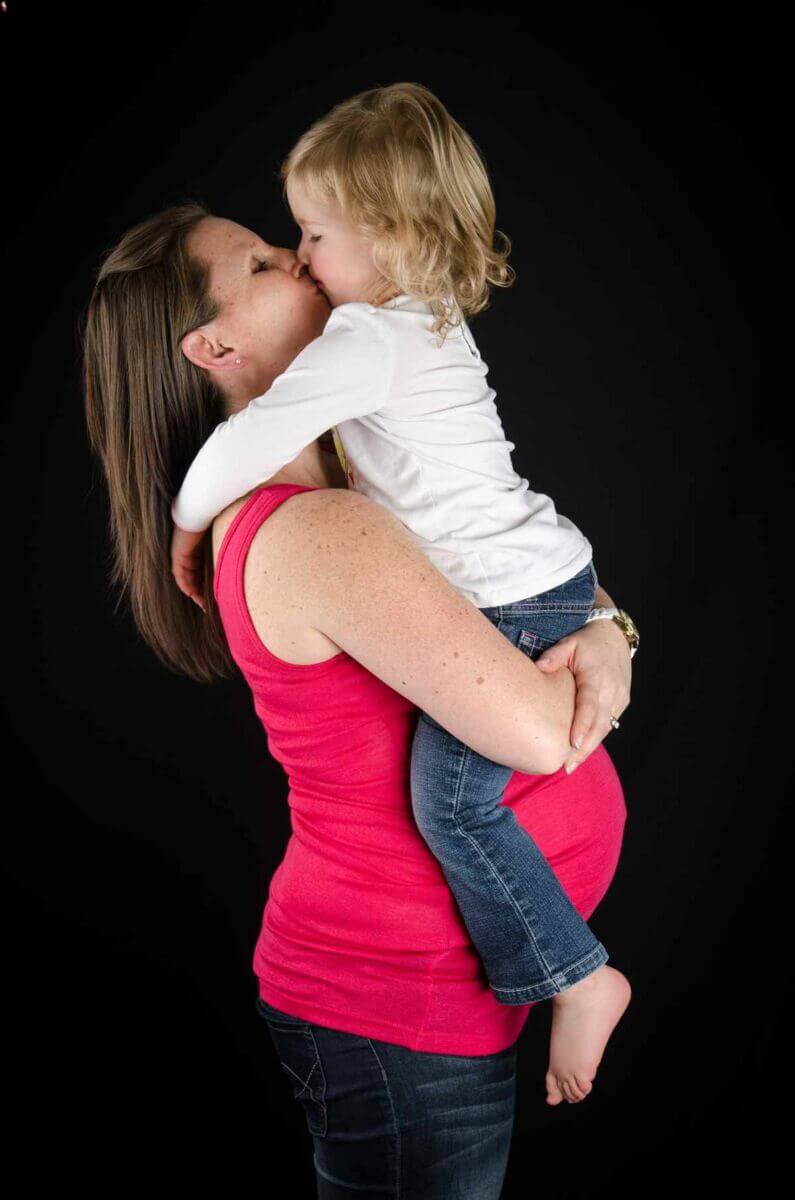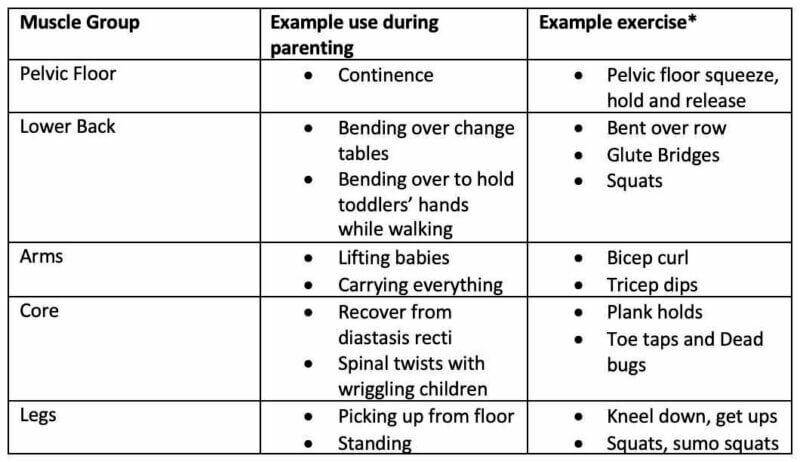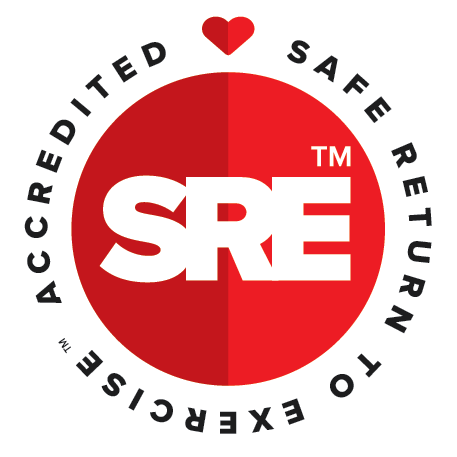How to help prevent injuries from carrying a baby or toddler

The repetitive motions of caring for a child and recovering from pregnancy and birth make new parents prone to injuries. Pain can impact both mums and dads. With a few techniques we can try to minimise our chance of pain or injury.
For those in a rush, here’s the shortlist:
- Prepare and be aware – that’s resistance training and muscle growth;
- Use good technique AND include pelvic floor and TA activation;
- Get your child to help you if it’s age-appropriate;
- Use ergonomic tools;
- Stretch, roll and massage;
- See professionals.
For those with time, let’s delve into those six key prevention areas:
1. Prepare and be aware
I’m a little biased, but this is number one for me. Strong, well-functioning muscles are protective.
They prevent pain from starting by training your muscles how to move effectively and safely. Strong muscles provide structure and support for your bones and help prepare for all the motions of caring for a baby. Women can train throughout their pregnancy, and men are also recommended to start to incorporate movements specific to parenting. To stay safe, it’s recommended you exercise with a MumSafe™ trainer and see a Women’s Health Physio for a pelvic floor check-up.

Be aware as a new mum that your body has changed. Hormones have changed how your ligaments and muscles stretch and attach. You may have diastasis recti (abdominal separation) and a weaker pelvic floor. It takes mental effort to focus on each of these areas every time you do any movement with your child or as exercise. Pay attention to quality of all movements and where you position yourself to perform tasks.
Please note: these are general – always train to your weakest link.
2. Use good technique
Most baby and toddler care activities are repetitive. This means that relatively small damage can accumulate so getting the right technique is vital to prevent injury. By the 20th nappy… or the 120th 3am breastfeed… your muscles will thank you for taking the extra time to get it right. Below are some minor adjustments you can make to some of the common actions to protect yourself:
- Rocking baby: hold baby with a straight wrist – keep your forearm, wrist and hand in a straight line instead of bending at the wrist. Take frequent breaks.
- Lifting babies from floor: bend at the knees, hold baby close to centre, come to one knee then step up. Don’t forget pelvic floor and TA activation.
- Breastfeeding: shoulders back and down.
- Carrying: hold central to your body (if you must side carry, frequently switch sides) – TA activation here when needed will help to support your lower back.
Stroller out of car: stand directly in front to avoid twisting back. Pull it close to the edge (don’t work leaning over) and make sure pelvic floor and TA are activated. - Sneezing, coughing: contract your TA, pelvic floor.
3. Get your child to help you
Encouraging your child to get involved in safe movement will have you both enjoying benefits:
- As soon as they can sit – offer your fingers and let them pull themselves to sitting first. They’ll enjoy practicing this skill, and you’ll get a better opportunity for grip around their torso with less bending. Stand up by going to your knees, then one knee, then pushing up.
- As soon as they can stand – help them stand first and then come down to pick them up, using the same kneeling strategy as when they could sit.
- As soon as they can step – get them to stand up on a step. By this stage, your little one might be starting to hit double digits in weight. Getting those kilos to come up to as close as safe working height (around your waist) as possible will help your back. Always watch for falls, and be close by with a hand.
- Hold on – when carrying your baby once they are around 8 months, you can start to encourage them to grip onto your clothes. This will pull them in closer to you and help minimise the support.
4. Use ergonomic tools
Minimise the load on your body by setting up your environment to prevent unnecessary turning, stretching and awkward positions.
- Change station – place key items (nappies, cream, wipes, change of clothes) within easy reach. If possible, stand at the foot end.
- Baby carrier – check that it’s worn properly, and use this to save your wrists.
- Adjustable height cot – before your baby can roll or stand, many cots allow you to have the base higher so that you don’t have to bend over the sides so far to reach bub. And when you do pick up, ensure PF and TA are activated.
- Light weight pram with adjustable height handle – putting the handle at the right height will encourage good posture and prevent hunching which can lead to sore shoulders. As you pick up the pram from the car, the lighter the better.
- Breastfeeding pillows – support your baby’s weight while feeding with pillows behind their back rather than just your arms.
5. Stretch, roll and massage
Finding time can be hard, but rewarding your muscles with a stretch will ensure they stay flexible and ensure a good range of motion. Tight muscles aren’t functional muscles. Invest in a foam roller. Use a spikey ball or tennis ball for myofascial release. Pay for a masseuse. Yoga and meditation. Gentle stretches. However you do it, helping those muscles loosen up and stay flexible will go a long way to protecting your from injury.
A training program like Fit For 2 with a MumSafe™ trainer can help you become strong from the inside out.
6. See professionals
Circumstances and causes for pain are unique, so invest in your health and see one of a range of professionals to ensure you are receiving adequate care. Your team might include:
- A MumSafe™ trainer – for strength training, pain prevention and stretching.
- A physiotherapist, osteo, acupuncture or chiro – for pain specific exercises, range of motion improvement, ergonomic support.
- A GP or Dr. of Traditional Chinese Medicine – for managing inflammation, pain, chronic conditions, and referrals.
Most importantly always listen to your body.
As a busy mum make sure you schedule in self-care for YOU!
It’s a good thing to do something for you and your health at least 3 times a week so you feel good about yourself again and reduce the chance of injuries.
Anita Guerra is a Registered Midwife and Certified Fitness Trainer. She runs Fit For 2 in South Morang, Victoria. To find out more about her and get in touch, click here.
You can also find her on Instagram.
Anita Guerra runs Fit For 2 in Victoria, . Learn more about Anita and Book your Trial today.
